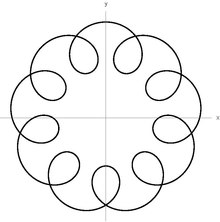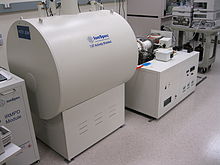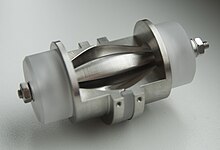Ion trap
This article has multiple issues. Please help improve it or discuss these issues on the talk page. (Learn how and when to remove these template messages)
|
Penning traps can be used for precise magnetic measurements in spectroscopy. Studies of quantum state manipulation most often use the Paul trap. This may lead to a
History
The physical principles of ion traps were first explored by F. M. Penning (1894–1953), who observed that electrons released by the cathode of an ionization vacuum gauge follow a long cycloidal path to the anode in the presence of a sufficiently strong magnetic field.[6] A scheme for confining charged particles in three dimensions without the use of magnetic fields was developed by W. Paul based on his work with quadrupole mass spectrometers.
Ion traps were used in
Theory
Any charged particle, such as an
Paul Trap
A Paul trap that uses an oscillating quadrupole field to trap ions radially and a static potential to confine ions axially. The quadrupole field is realized by four parallel electrodes laying in the -axis positioned at the corners of a square in the -plane. Electrodes diagonally opposite each other are connected and an a.c. voltage is applied. Using Maxwell's equations, the electric field produced by this potential is electric field . Applying
- .
Assuming that the ion has zero initial velocity, two successive integrations give the velocity and displacement as
- ,
- ,
where is a constant of integration. Thus, the ion oscillates with angular frequency and amplitude proportional to the electric field strength and is confined radially.
Working specifically with a linear Paul trap, we can write more specific equations of motion. Along the -axis, an analysis of the radial symmetry yields a potential[10]
- .
The constants and are determined by boundary conditions on the electrodes and satisfies Laplace's equation . Assuming the length of the electrodes is much greater than their separation , it can be shown that
- .
Since the electric field is given by the gradient of the potential, we get that
- .
Defining , the equations of motion in the -plane are a simplified form of the
- .
Penning Trap

A standard configuration for a Penning trap consists of a ring electrode and two end caps. A static voltage differential between the ring and end caps confines ions along the axial direction (between end caps). However, as expected from Earnshaw's theorem, the static electric potential is not sufficient to trap an ion in all three dimensions. To provide the radial confinement, a strong axial magnetic field is applied.
For a uniform electric field , the force accelerates a positively charged ion along the -axis. For a uniform magnetic field , the Lorentz force causes the ion to move in circular motion with cyclotron frequency
- .
Assuming an ion with zero initial velocity placed in a region with and , the equations of motion are
- ,
- ,
- .
The resulting motion is a combination of oscillatory motion around the -axis with frequency and a drift velocity in the -direction. The drift velocity is perpendicular to the direction of the electric field.
For the radial electric field produced by the electrodes in a Penning trap, the drift velocity will precess around the axial direction with some frequency , called the magnetron frequency. An ion will also have a third characteristic frequency between the two end cap electrodes. The frequencies usually have widely different values with .[11]
Ion trap mass spectrometers

An ion trap
Other types of mass spectrometers may also use a linear quadrupole ion trap as a selective mass filter.Penning ion trap

A
Penning traps can be used in
The Penning Trap was invented by Frans Michel Penning and Hans Georg Dehmelt, who built the first trap in the 1950s.[19]
Paul ion trap

A Paul trap is a type of
Kingdon trap and orbitrap

A Kingdon trap consists of a thin central wire, an outer cylindrical electrode and isolated end cap electrodes at both ends. A static applied voltage results in a radial logarithmic potential between the electrodes.[22] In a Kingdon trap there is no potential minimum to store the ions; however, they are stored with a finite angular momentum about the central wire and the applied electric field in the device allows for the stability of the ion trajectories.[23] In 1981, Knight introduced a modified outer electrode that included an axial quadrupole term that confines the ions on the trap axis.[24] The dynamic Kingdon trap has an additional AC voltage that uses strong defocusing to permanently store charged particles.[25] The dynamic Kingdon trap does not require the trapped ions to have angular momentum with respect to the filament. An Orbitrap is a modified Kingdon trap that is used for mass spectrometry. Though the idea has been suggested and computer simulations performed[26] neither the Kingdon nor the Knight configurations were reported to produce mass spectra, as the simulations indicated mass resolving power would be problematic.
Trapped ion quantum computer
Some experimental work towards developing quantum computers use
See also
References
- S2CID 15918021.
- .
- S2CID 316118.
- S2CID 206511320.
- S2CID 119075546.
- .
- ^ Hartson, Ted (2004). "How the World Changed Television" (PDF). Retrieved 2008-10-13.
- ^ Magnet for cathode-ray tube ion traps
- ^ Ion Trap for a Cathode Ray Tube
- ISBN 0198506961.
- ISBN 0198506961.
- .
- PMID 15389865.
- .
- PMID 15838939.
- doi:10.1103/RevModPhys.58.233. Archived from the original(PDF) on 2017-03-13. Retrieved 2014-08-09.
- ^ Häffner, Hartmut, Christian F. Roos, and Rainer Blatt. "Quantum computing with trapped ions." Physics Reports 469.4 (2008): 155–203.
- ^ Marshall, A. G.; Hendrickson, C. L.; Jackson, G. S., Fourier-transform ion cyclotron resonance mass spectrometry: a primer. Mass Spectrom Rev 17, 1–35.
- ^ "Hans G. Dehmelt – Biographical". Nobel Prize. 1989. Retrieved June 1, 2014.
- ^ Paul W., Steinwedel H. (1953). "Ein neues Massenspektrometer ohne Magnetfeld". RZeitschrift für Naturforschung A 8 (7): 448–450
- ^ DE 944900 "Verfahren zur Trennung bzw. zum getrennten Nachweis von Ionen verschiedener spezifischer Ladung", W. Paul and H. Steinwedel, filed on December 24, 1953, priority December 23, 1953
- .
- ISBN 3-540-22043-7.
- doi:10.1063/1.92315.
- PMID 9911663.
- .
External links
- VIAS Science Cartoons A cranky view of an ion trap...
- Paul trap




































